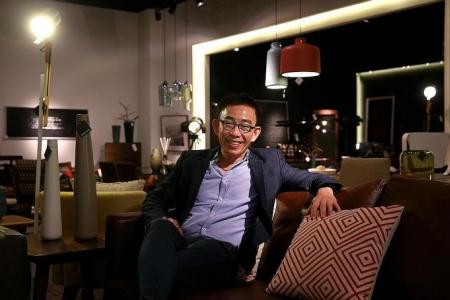Fame and fortune with furniture
We may be tiny, but we're punching above our weight when it comes to the furniture industry. Singapore has 1.05 per cent share of the global consumption and the industry would have reached $6.25 billion last year. CHAI HUNG YIN (chaihyn@sph.com.sg) finds out how our companies are making waves
Koda, a Singapore-listed company, has 11 purpose-built factories in Malaysia, Vietnam and China.
It exports to more than 50 countries and, in China alone, its furniture design and lifestyle arm, called Commune, will have over 50 retail outlets by the end of this year.
Koda's development mirrors the tale of Singapore's furniture industry.
From humble beginnings, both Koda and the sector had to make rapid changes. For instance, Singapore was once the cheapest place to manufacture furniture in the 1970s, but has now transformed into a market for bespoke designer furniture.
Koda, too, has come a long way since it was founded in 1972 by Mr Koh Teng Kwee, now 83.
Mr Koh, who came from China when he was 17, learnt English by taking night classes. He later graduated with a craftsman certificate from a London vocational institute - equivalent to a polytechnic diploma - to teach design, carpentry and furniture manufacturing in a technical school here.
He struck out on his own - hand-built his factory in Eunos from scratch, stocked with used equipment. But it burned down two to three years later. Undeterred, he rebuilt.
What started out as a cottage industry with about 60 workers has grown despite several relocations and fire incidents, said Mr Koh's youngest son, Mr Ernie Koh, 50, who is now the executive director of sales and marketing in Koda.
The company had to move manufacturing first to Malaysia when costs went through the roof.
And the elder Mr Koh was one of the first few to run factories in Vietnam in the early 1990s. He even got into trouble with the authorities there because of paperwork issues with his visas.
"Being the first mover gave us a lot of margin, but also a lot of headache," the younger Mr Koh said.
Unwilling to rest on his laurels, Mr Koh went to Kunshan, China, bought a plot of land and built a factory there between 1993 and 1996. The company sold it six years ago to cash in on the high property prices and also because of soaring manufacturing costs.
The company went public in 2001.
By then, instead of manufacturing other people's designs and striving to be the cheapest manufacturer, it had started using its own original designs.
"That suddenly gave us a niche - we are able to price ourselves a little bit because we have the design, and sales and marketing service elements," said the younger Mr Koh.
He would travel to various locations around the world, identify trends, get inspired and transform them into real designs.
NEW BLOOD
Today, the company is looking for its growth spurt from the next generation of leaders within the family.
He added: "If we want to transform, we cannot use old dogs. You cannot teach an old dog new tricks."
Enter the family's third generation - the younger Mr Koh's nephews, whom he described as street-smart, design-trained and finance-trained.
Together, they gave birth to Commune, which has become phenomenally popular in China because a Singapore brand is considered a premium one there.
Within three years, it had 20 franchises there and will hit more than 50 by the end of the year.
The younger Mr Koh said that being a Singapore company and a Singapore brand in the regional market is a strength that it capitalises on.
He said: "Anyone can copy the designs or your ideas. But nobody can copy where you are born."
As e-commerce takes off and more people do their shopping online, the younger Mr Koh said the challenge lies in getting customers to narrow down their choices to his brand.
"When it comes to younger people who are more savvy, you need to have a niche. We want to be unique and be seen as customised," he said.
The company continues to watch emerging trends, such as 3D printing and technologies, that could be a game-changer.
The younger Mr Koh said: "You need to keep an eye on it and embrace it. If you embrace it when it comes, it is too late."
When it comes to younger people who are more savvy, you need to have a niche. We want to be unique and be seen as customised.
- Mr Ernie Koh, executive director of sales and marketing in Koda
Free of baggage, S'pore designers more open

They design furniture for high-end European brands such as French designer label Ligne Roset, Sweden's Bla Station and Denmark's Bolia.
Closer to home, you can find furniture designed by them in the showrooms of home-grown furniture company Scanteak.
Singaporeans Gabriel Tan, 33, and Wendy Chua are part of Outofstock, a four-member collective that produces award-winning designs for the global market.
When he was an industrial design undergraduate at the National University of Singapore, Mr Tan won the first Asia Award of Bombay Sapphire Designer Glass Competition 2005 at the Tokyo Design Week, Japan.
That got him a ticket to the Milan Furniture Fair, the largest trade fair of its kind in the world, where his work was exhibited.
He and his classmate, Ms Chua, took part in the Electrolux Design Lab 2005 and emerged champions with their waterless washing machine concept.
At the competition, they met Gustavo Maggio, an Argentinian and Sebastian Alberdi, a Spaniard, with whom they formed Outofstock.
The group secured international high-end brands as clients, which means their designs are now in production and sold worldwide, in places such as the US, France, Sweden, Denmark, Japan, Taiwan and Spain.
SOUGHT AFTER
Mr Tan, who also runs his own design firm, has been invited to design new furniture based on the Shaker community in the US, and the exhibition is slated for next month.
On why Singapore designers are sought after internationally, Mr Tan said: "Singapore is part of a new wave that is starting to be recognised internationally. Designers from Singapore have, in the past 10 years, been exhibiting overseas and working with European companies.
"It is hard work that has been put in since 2005, or even before that, when companies started to put more effort into it. We are just starting to see the fruit.
"More effort is needed to nurture it, so that in 20 years' time, people can view Singapore like Japan or other design-rich countries."
Besides, Singapore has less cultural baggage and this could work to the advantage of designers.
Said Mr Tan: "Rather than trying to fit in with a fixed national aesthetics or identity, we are free of baggage and we can be more open."
He said that design will become the hallmark of the Singapore furniture industry.
"We are not the pioneers, but we are still the early runners. Our design culture really started less than 20 years ago. Compared to other nations, there are still opportunities."
Singapore is part of a new wave that is starting to be recognised internationally. Designers from Singapore have, in the past 10 years, been exhibiting overseas and working with European companies.
- Mr Tan of Outofstock
THE S'PORE FURNITURE INDUSTRY
IN NUMBERS
- Made up of 1,921 companies
- Employs 19,700 workers
- Contributes about $1 billion in value add to the economy
THE SINGAPORE BRAND NAME
- Market size has been growing at a rate of 7.4 per cent from 2012 to last year
- Global footprint in 80 countries worldwide
REASONS FOR INTERNATIONAL SUCCESS
- Perceived premium of a Singapore brand
- Necessity to venture overseas due to the small market here
- Good trade association
HOW INDUSTRY HAS GROWN
"We realise that unity is strength. The whole is greater than the sum of its parts," said Mr Ernie Koh, 50, president of the Singapore Furniture Industries Council (SFIC), which has 350 members and 40 staff.
SFIC organised its first International Furniture Fair here in 1984 and it became an important platform for its members to showcase their products.
In 1996, it ventured into China and about eight companies invested in an industrial park there. They worked together to negotiate with the Chinese government.
As the furniture industry matured, it transformed from a production-based industry into one that is focused on design.
To address manpower issues, SFIC set up a training institute where it recruits, trains and places skilled workers with companies.
It also has an eye on the future, including 3D printing technology.
Mr Koh said: "Say you need extra stools for a party. You may one day be able to download the design of a stool and print it out using 3D printing. After the party, you put the plastic chair back and recycle it."
Get The New Paper on your phone with the free TNP app. Download from the Apple App Store or Google Play Store now


